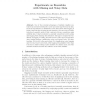Free Online Productivity Tools
i2Speak
i2Symbol
i2OCR
iTex2Img
iWeb2Print
iWeb2Shot
i2Type
iPdf2Split
iPdf2Merge
i2Bopomofo
i2Arabic
i2Style
i2Image
i2PDF
iLatex2Rtf
Sci2ools
MCS
2004
Springer
2004
Springer
Experiments on Ensembles with Missing and Noisy Data
Abstract. One of the potential advantages of multiple classifier systems is an increased robustness to noise and other imperfections in data. Previous experiments on classification noise have shown that bagging is fairly robust but that boosting is quite sensitive. Decorate is a recently introduced ensemble method that constructs diverse committees using artificial data. It has been shown to generally outperform both boosting and bagging when training data is limited. This paper compares the sensitivity of bagging, boosting, and Decorate to three types of imperfect data: missing features, classification noise, and feature noise. For missing data, Decorate is the most robust. For classification noise, bagging and Decorate are both robust, with bagging being slightly better than Decorate, while boosting is quite sensitive. For feature noise, all of the ensemble methods increase the resilience of the base classifier.
| Added | 02 Jul 2010 |
| Updated | 02 Jul 2010 |
| Type | Conference |
| Year | 2004 |
| Where | MCS |
| Authors | Prem Melville, Nishit Shah, Lilyana Mihalkova, Raymond J. Mooney |
Comments (0)

